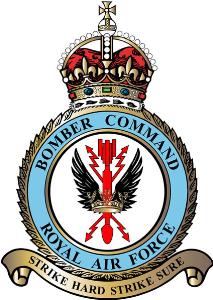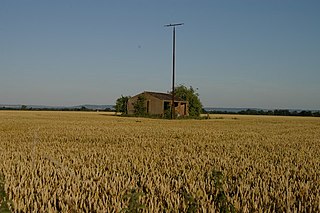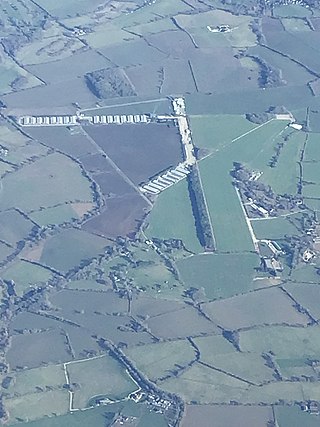
RAF Bomber Command controlled the Royal Air Force's bomber forces from 1936 to 1968. Along with the United States Army Air Forces, it played the central role in the strategic bombing of Germany in World War II. From 1942 onward, the British bombing campaign against Germany became less restrictive and increasingly targeted industrial sites and the civilian manpower base essential for German war production. In total 364,514 operational sorties were flown, 1,030,500 tons of bombs were dropped and 8,325 aircraft lost in action. Bomber Command crews also suffered a high casualty rate: 55,573 were killed out of a total of 125,000 aircrew, a 44.4% death rate. A further 8,403 men were wounded in action, and 9,838 became prisoners of war.

No. 8 Group RAF was a Royal Air Force group which existed during the final year of the First World War and during the Second World War.

No. 100 Group was a special duties group within RAF Bomber Command. The group was formed on 11 November 1943 to consolidate the increasingly complex business of electronic warfare and countermeasures in one organisation. The group was responsible for the development, operational trial and use of electronic warfare and countermeasures equipment. It was based at RAF stations in East Anglia, chiefly Norfolk.

No. 5 Group RAF was a Royal Air Force bomber group of the Second World War, led during the latter part by AVM Sir Ralph Cochrane.

No. 3 Group RAF of the Royal Air Force was an RAF group first active in 1918, again between 1923 and 1926, then as part of RAF Bomber Command from 1936 to 1967, and recently part of RAF Strike Command from 2000 until it disbanded on 1 April 2006.
No. 630 Squadron RAF was a heavy bomber squadron of the Royal Air Force during the Second World War.
No. 622 Squadron RAF is a reserve aircrew squadron of the Royal Auxiliary Air Force. During World War II, it operated as a bomber squadron of the Royal Air Force. Post-war it served shortly as a transport squadron in the RAuxAF.

RAF Oakley is a former Royal Air Force satellite station between Oakley and Worminghall, Buckinghamshire, England. It was located in a flat, damp wooded area.

RAF Westcott is a former Royal Air Force station located near Westcott in Buckinghamshire, England. The site fully opened in September 1942 and was the base of No.11 Operational Training Unit (OTU) flying the Vickers Wellington medium bomber until the RAF moved out in August 1945, the station was officially closed on 3 April 1946.
No. 625 Squadron RAF was a heavy bomber squadron of the Royal Air Force during the Second World War.
No. 582 Squadron RAF was a bomber pathfinder squadron of the Royal Air Force during the Second World War.
No. 189 Squadron was a Royal Air Force squadron.
No. 626 Squadron RAF was a heavy bomber squadron of the Royal Air Force from 1943 to 1945.

No 620 Squadron was a squadron of the Royal Air Force during World War II. During its existence it served as a bomber squadron, airborne forces and a transport squadron.

No. 463 Squadron RAAF was a Royal Australian Air Force heavy bomber squadron during World War II. The squadron was formed in the United Kingdom in late 1943 from personnel and aircraft allocated from No. 467 Squadron RAAF. The squadron was equipped with Avro Lancaster bombers and flew its first raids on Germany immediately after being formed. Operating as part of RAF Bomber Command No. 463 Squadron conducted raids against cities, industrial facilities and military targets in Germany, France and Norway throughout 1944 and until the end of the war in May 1945. Following the war, the squadron evacuated Allied prisoners of war from Europe until it was disbanded in late 1945.

Raymond Brown Hesselyn, was a New Zealand fighter pilot and flying ace of the Second World War, credited with the destruction of at least 18 enemy aircraft while flying with the Royal Air Force (RAF) over Europe and the Mediterranean.

No. 576 Squadron RAF was a Royal Air Force Second World War heavy bomber squadron.
Juvincourt Airfield is an abandoned military airfield, which is located near the commune of Juvincourt-et-Damary in the Aisne department of northern France.

Royal Air Force Wing or more simply RAF Wing is a former Royal Air Force station, situated just west of the village of Wing, in the Aylesbury Vale district of Buckinghamshire, England.

RAF Helperby, was a First World War era airfield near to the villages of Brafferton and Helperby in North Yorkshire, England. It was used initially by No. 33 Squadron RAF, and then later by No. 76 Squadron RAF in the home defence (HD) role. During the Second World War, the site was used as an ammunition supply depot, being operated by No. 92 Maintenance Unit RAF, and also by the USAAF. The site was known to have stored mustard gas and other chemical weapons during the period of the Second World War.












